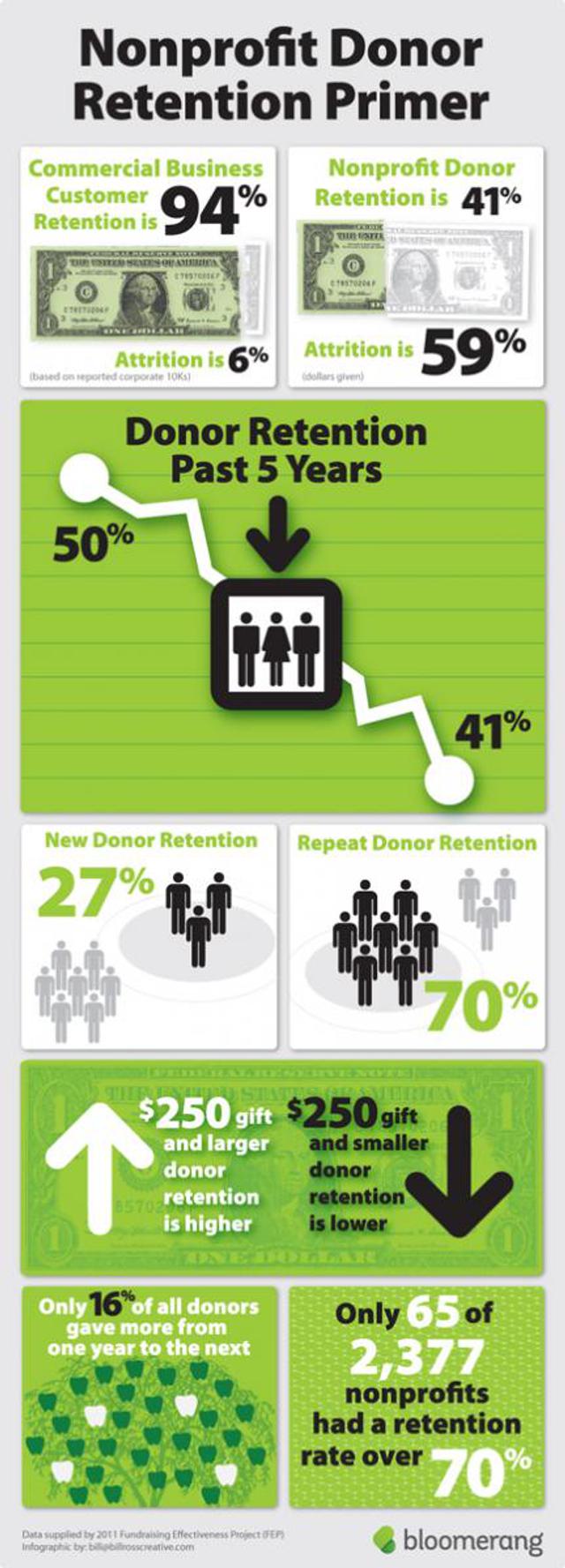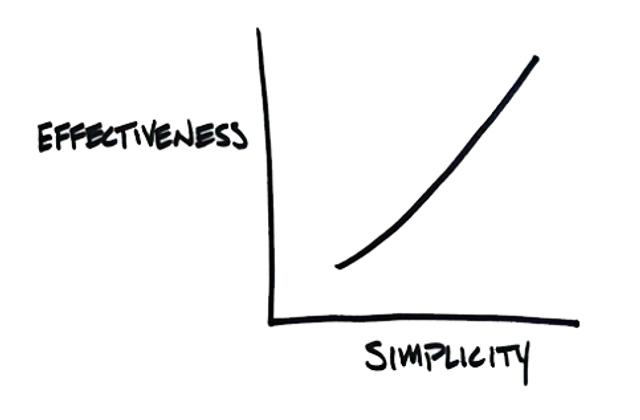The great donor exodus, and what to do about it. A three-part series from Jay Love
- Written by
- Jay Love
- Added
- May 20, 2013
The first article below originally appeared on the influential Katya’s non-profit marketing blog on 9 January 2013, with the following introduction from Katya. The graphic that accompanies it formed an important part of the interview which resulted in Chuck Longfield’s recently-posted feature on SOFII, We can boost donor retention, but only if we get smart. Here’s what Katya said:
‘This is a really important guest post. If you are in the business of fundraising in any way, it’s recommended reading. Please also share it, because our sector needs to see this data and act accordingly. Thanks to the author, Jay Love, for putting this together in such a compelling way. Jay is the former CEO of eTapestry. He is currently CEO of Bloomerang and SVP of Avectra while serving on numerous local and national nonprofit boards. He’s very smart about this topic.’
Because SOFII agrees with Katya that this is important stuff we’re reprinting the article here, followed by another from Jay on donor’s reasons for leaving and a bonus feature on simplicity.

How we’re losing donors
Ever since the Urban Institute and the Association of Fundraising Professionals created the Fundraising Effectiveness Project a few years ago, I have been tracking the results religiously. They provide a near real-time scorecard on what is driving the bulk of charitable giving in our country. The headline of the results is this: ‘repeat donors matter most’. But we are terrible at keeping them. The good news is we could double the fundraising results of most nonprofits by doing a better job keeping our donors. Just imagine what impact such an increase could have on virtually all charity missions.
What’s wrong?
Here’s my team at Bloomerang‘s visual analysis of just how badly we’re doing - see opposite. It shows why I’m an advocate for doing better.
What jumps out at you here is the comparison of the commercial sector result of 94 per cent versus the charity sector’s of 41 per cent. That is a drastic difference by any means of comparison. I do not believe the donor retention percentage will ever be the same as those derived from customers paying for a service they use daily and, in most cases, where they spent decent sums of money implementing.
However, as the bottom right corner block of information states, there are nonprofits that achieve a rate of 70 per cent or higher. Every organisation should establish a goal for what its donor retention should be. Unfortunately, many organisations are not aware of their current rate or, if they know it, do not share it with either their staff or board.
What to do about it
To fix this problem at your nonprofit, you need to start with your own data. Track the various retention rates below, comparing those rates with the ones I share here. As the old adage goes, what is measured is what improves. Some key retention rates to track are:
- First year donor retention rate by dollars (value).
- First year donor retention rate by number of donors.
- Repeat donor retention rate by value.
- Repeat donor retention rate by number of donors.
- Overall donor retention rate by value.
- Overall donor retention rate by number of donors.
Coupled with the above, are the added measures of tracking ‘upgrades’ and ‘downgrades’. Together these metrics provide solid data to use for establishing individual key objectives and goals. Next, read the recommendations of Professor Adrian Sargeant. His website will give you an MBA in donor retention principles and practices here.
My hope is that each of you reading this post garners an insight or a concept that allows you to improve your organisation’s retention levels enough to truly double the lifetime value of your donor database.

Why donors stop their support
With the extreme importance of the topic my title introduces, you would think there would be a large amount of research and hundreds of articles about it. Unfortunately, that is not the case.
The cornerstone of support and funding of most charitable causes around the world is a dedicated group of loyal supporters. For smaller charities this may be less than a hundred people, including the board of directors. Larger charities rely on the support of thousands of multi-year supporters from various channels.
How in the world then could this phenomenon of ‘loyalty to a cause’ not be studied as much, if not more so, than the fuel economy in vehicles or weather patterns in Antarctica? Should not every charity in the world know what causes sudden, or the not-so-sudden, departure of its loyal supporters and then design methods or systems to alleviate those causes? My previous guest blog post for Katya outlined how even a small 10 per cent improvement in donor retention could double the lifetime revenue stemming from your donors in your database. Therefore, the incentive should be there!
As I did in my previous post, I am going to compare research pulled from the commercial sector. In this case, we will look at why a commercial customer leaves. Are there parallels to the reasons why donors leave? Can the immense amount of research compiled by commercial business on this topic and, more importantly, the systems designed to reduce the likelihood of those reasons happening be copied in some manner? My answer is yes.
Notice the comparison of reasons in the nonprofit donor loyalty primer below. (Problems viewing this infographic? Go here.)
The research is pulled from our chief scientist, Adrian Sargeant, and from The Rockefeller Corporation
Although both sides of the image show why the customers or donors are heading to the exit, more donors are leaving because they can no longer afford to donate. This is not surprising since supporting a nonprofit is discretionary compared with buying food or paying for housing, transport, clothing, etc. The biggest lesson for nonprofits, which rely on donor support for all or some portion of their operating budget, is how vital proper communication processes and messages are. Notice how the following items add up to 53 per cent of the reasons why donors leave:
- Thought the charity did not need them – five per cent.
- No information on how monies were used – eight per cent.
- No memory of supporting – nine per cent.
- Never thanked for donating – 13 per cent.
- Poor service or communication – 18 per cent.
Just imagine what a solid communication plan built upon a top-notch CRM/database solution could do for each item above. Since loyalty is based upon strong relationships and relationships grow via proper and regular communications, efforts in this area can provide huge upward surges in loyalty and financial support.
What do you think? Is it worth the extra effort here?
A plea for simple systems
Why are less features and more ease of use radical, with fundraising software?
Even though I often remark about ‘less is more’ in software, not just for nonprofits, but for any software, I must admit the writing of this post was stimulated by a great article I read recently. The article, in Wired magazine, was written by Mat Honan and entitled The Simple Complex.
The first sentence grabbed me,‘Simple doesn’t just sell, it sticks.’
Mat went on to state how simplicity made huge hits out of products such as the new Nest thermostat, TiVo, Fitbit and even the age old Swiss army knife. If that is the case, why do electronic products, and more importantly software, often become bloated in later versions or iterations?


Tough software development decisions

Mike Monteiro, author of Design is a Job, states, ‘simplicity is about subtraction’. The Wired article says, and I so agree, such adherence to pure and utter simplicity saved Apple. Would we all not be better off if the next version of Microsoft Word cut out the 75 per cent of the product 98 per cent of us never use? Are we not all happier because Google never expanded their search screen beyond this?
It is much easier to let software expand and bloat rather than ruthlessly making them simpler and easy to use. As the French philosopher Blaise Pascal stated, ‘I have made this longer than usual because I have not had time to make it shorter.’ More often than not, in their zest to please everyone by keeping every feature under sun, the software developers actually make their products progressively more difficult to use and nearly impossible for beginners. Just ask anyone trying to learn a product that has been around more than 10 years in the nonprofit world!
Both fundraising software and nonprofit CRM are guilty
Over the years I have witnessed this happening with fundraising software and now nonprofit CRM applications. The Fund-Master programme I demonstrated in the early 1980s was simple enough so that little or no training was required. Over time, we tried to make everyone happy, including those buyers who insisted on check marks being placed within a much too large spreadsheet. What happened? Bloat on top of bloat, which led to complexity and a week or more of training to understand, even though it did less than today’s smartphones. Can you even imagine if your new smartphone required a full week of training? The growth of that industry would stop immediately!
In fact, stopping immediately is usually what happens in most fundraising departments when the inevitable turnover of a key end user of the fundraising software occurs. All those check marks on the decision-making spreadsheet, which seemed so wonderful then, now mean a steep learning curve, large amounts of lost time and the extreme likelihood of only using 10 per cent of the functions available.
Can we stop this insanity now?
I know those are strong words above, but honestly, would it not be better if the 10-20 per cent of the functions you really need and use in your fundraising office could be simple and easy? Think of the impact it would have on the strategic functions you should be doing daily. Key results, such as a higher level of donor retention, could be the focus rather than spending days learning arcane keystroke patterns. Mat Honan summed it up quite well in the final paragraph of his article.
‘Simplicity is actually quite simple. It requires paring things away when market forces tell you to add. It means removing layers rather than adding them. In short, all it takes is a bit of courage.’
© SOFII/ Jay Love 2013
















